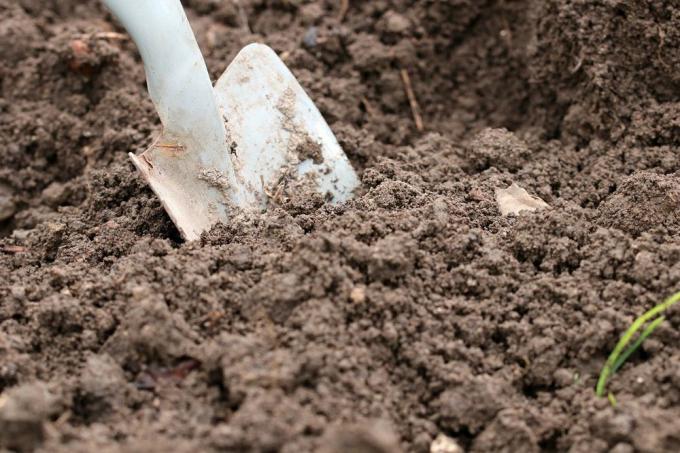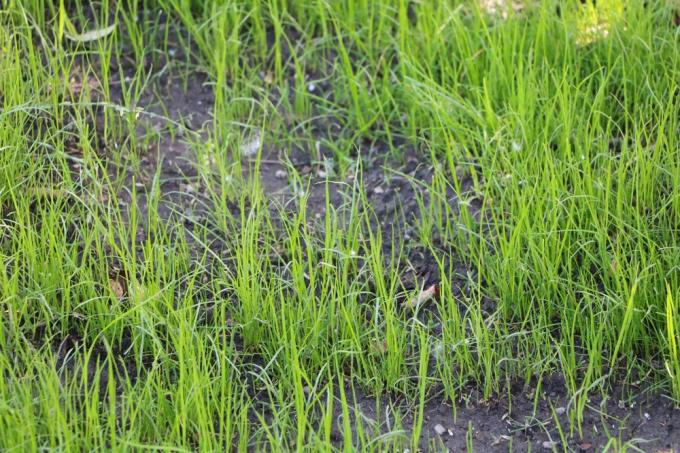
table of contents
- Calculate the amount correctly
- Thickness of the substrate layer
- frequently asked Questions
When creating a new lawn or when filling a lawn area, special lawn soil is useful. In this article we will explain how much you need and how you calculate the required amount.
In a nutshell
- Rule of thumb: 10 l of lawn substrate per square meter of surface
- The requirement is calculated from the length times the width of the lawn plus the thickness of the substrate layer
- The substrate layer should ideally be between two and four centimeters thick
- two centimeters thick for less exposed ones race respectively. Lawn on good surfaces
- three to four centimeters thick for sports and play lawns or less optimal substrates
Calculate the amount correctly
As a rule of thumb, it is recommended to apply ten liters of lawn substrate per square meter of lawn area - bought or mixed yourself. The layer should be between two and four centimeters thick. How much lawn substrate you need can be calculated using this formula:

Length x width x depth results in the required amount in cubic meters
Measure the length and width of the lawn and determine how thick the substrate layer should be. Now you can calculate the amount. Now the amount of liters can also be determined, because one cubic meter corresponds to 1000 liters.
example
Suppose you want to re-sow an area of 20 square meters (five meters long by four meters wide) with lawn. They have a thick topsoil layer and rather sandy soil, so the substrate layer only needs to be two centimeters thick.
- 20 square meters by 0.02 meters is 0.4 cubic meters
- 0.4 cubic meters x 1000 equals 400 liters
For a 20 square meter newly laid lawn you need 400 liters of lawn substrate. Here it is worthwhile to either mix it yourself or to buy a pallet right away - for example, 36 sacks with 45 liters of soil each, a total of 1620 liters.
Thickness of the substrate layer
The thickness of the substrate layer depends on these requirements:
- Subsoil (humic, little humic; permeable, not very permeable, etc.)
- Soil composition (sandy, humic, loamy, etc.)
- PH value (acidic, neutral or alkaline)
- Type of lawn (ornamental lawn or hard-wearing lawn)
Basically, the substrate layer on problematic soils (heavy, less permeable, loamy) should be thicker as well as light or humus-rich soils. In addition, decorative lawns that are seldom stepped on require a thinner layer than heavily used sports and play lawns.

Tip: In advisors it is sometimes claimed that you no longer need to apply additional fertilizer when creating a new lawn. This is wrong, because lawn soils contain pre-fertilization for only six to eight weeks - after that, additional fertilization must take place.
frequently asked Questions
No, lawn and potting soil are different substrates. Although both soils consist of similar components, they are composed differently and have different nutrient compositions. Plants with a high need for nutrients are placed in potting soil; Turf soil, on the other hand, is optimally tailored to the needs of grasses. For this reason, potting soil is also not suitable for a lawn. Turf soil is a very fine substrate that is free of coarse particles.
If you want to mix your own lawn substrate, use it for this
- 50 percent ripe compost soil
-between 30 and 40 percent humus soil
-between 10 and 20 percent sand
These components are carefully mixed with the help of a shovel and then well sieved. Make sure that no coarse components such as roots, stones, etc. ä. remain in the soil mix. Incidentally, green waste compost is particularly suitable for lawn soil, as it is loose and has the right pH value.
Also topsoil or Mother earth can be used for the (new) planting of a lawn. The topsoil layer should be at least 15, better 20 to 25 centimeters thick so that the grasses can take root. You can get the material in different qualities (sifted / unscreened, with or without compost) from the building materials trade. But you can also inquire about companies in the field of gardening and landscaping or scour the classifieds, here sometimes larger quantities are sold cheaply.

